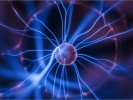Line 2. Phase transition of nuclear and hadronic matter
Coordinators: G. Boca, P. Camerini
Two experiments belong to this scientific line, ALICE, performed at the CERN Large Hadron Collider, and NA60+, to be performed at the CERN SPS. Their primary objective is the production of a state of nuclear matter characterized by extreme conditions of density and energy and obtained by colliding ultra-relativistic heavy ions. At sufficiently high energy densities, Quantum Chromo-Dynamics predicts that a transition from hadronic matter to a deconfined state of quarks and gluons (Quark-Gluon Plasma - QGP) should occur; a similar transition is assumed to have taken place in the early Universe, about one millionth of a second after the Big Bang. The purpose of both experiments is to the study of the physics of strongly interacting matter in the conditions when the QGP is formed.
In the ALICE experiment two heavy nuclei (typically lead nuclei) are accelerated in the LHC ring up to 2.5 TeV per nucleon and beyond. The thermo-statistical models indicate that at this energy the temperature reached by the QGP is around at 160 MeV and the baryochemical potential is approximately zero. This condition corresponds to a point of deconfined QGP in the phase diagram in a zone never explored by other experiments.
The NA60 + experiment proposes instead to study lead ions collisions at lower energies, from 20 to 160 GeV per nucleon, where the baryochemical potential is much higher and the temperature lower. The production cross-section of muon pairs will be studied, from 'thermal' energies up to those of the charmonium state. The cross-sections will then be compared with models involving first order phase transitions and chiral symmetry restoration. The measurement of meson and baryon production cross sections with open charm and strangeness will in turn allow the comparison with hadron-chemistry models and the study of the mass modification due to the effects of the nuclear medium.

The ALICE detector

The NA60+ experimental setup








